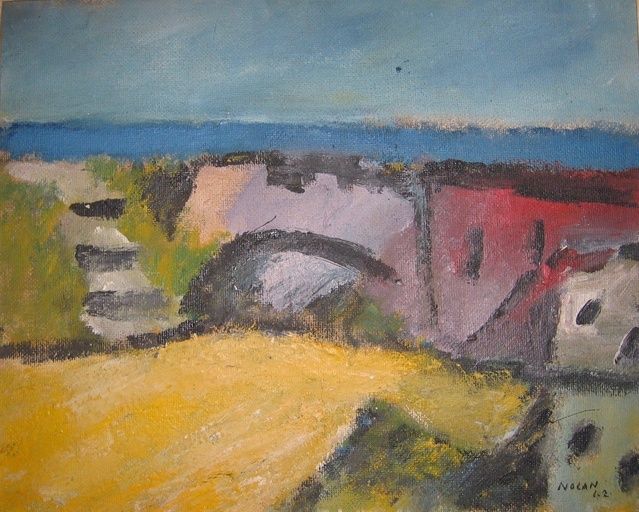

Untitled (Catani Arch, St Kilda) , 1942
Untitled (Catani Arch, St Kilda) 1942 oil on cotton gauze on board 37.0 x 45.5 cm signed and dated lower right: NOLAN 42 private collection, Canberra
David Rainey is an independent Australian writer and researcher. He co-curated the exhibition Ern Malley: the Hoax and Beyond at Heide Museum of Modern Art in 2007. His main area of interest is the avant-garde art and literature of WW2 Melbourne and later.
"Sidney Nolan was born the very same day Carlo Catani turned 65 and retired from the Public Works Department in Melbourne. The Florence-born engineer’s last major project had been reclamation of the St Kilda foreshore as a public space. His elegant arched footbridge linking the sea baths and tea rooms was built in 1916.
Much frequented by Nolan throughout his life, Catani Arch is captured evocatively in this little known 1942 painting.
Appropriately, given he knew Mary Boyd when he painted it and 36 years later she became his third wife, this work once graced the London home of the Boyd family.
Nolan grew up in St Kilda - in his words a ‘kitsch heaven’. Luna Park and its Big Dipper, the Palais Theatre, the Pier, Catani Gardens, the Esplanade - all promised youthful excitement and mature nostalgia.
He was 25 when he painted Catani Arch. For a year he had lived in a ménage à trois with John and Sunday Reed at Heide having finally accepted the reality that his marriage to Elizabeth Paterson was finished. What was more, Australia was at war, Japanese forces were advancing, he had been drafted into the army and stationed in the Mallee district of Western Victoria. The past was past, the present had its allure, but the future seemed bleak.
The painting though, reflects little of this. Rather, drawing on that ‘rare lyrical talent’ recognised in Nolan even then by fellow painter Albert Tucker, the work suggests a genius of vision that would soon blossom in his Wimmera paintings.
Painted on muslin covered board most likely prepared by Sunday Reed and taken to Nolan on a weekend visit, it displays ‘the radical flatness, high horizons, virtual absence of conventional linear perspective and bright primary colours’, recognised by Jane Clark in her 1987 Nolan retrospective Landscape and Legends as ‘interpreting the Australian landscape in an entirely new way.’
A colour-drenched work, with abstracted simplicity of form and Rouault-like outlining, Catani Arch’s gravel concourse and archway float diagonally like a yellow-frocked child.
Imagination is key. One can imagine Nolan here, a boy in his kitsch heaven; here, away from their parents, he and Elizabeth keep rendezvous; almost opposite, across the Esplanade in their Marli Place flat, their daughter is conceived; perhaps here, he and John Sinclair wonder at a full moon rising over the bay and he conjures up the iconic Moonboy image.
Here too, much later, he will walk with his daughter Amelda. Explaining to her the bitterness of his Paradise Garden verses about his Heide years and their acrimonious aftermath, he wrote ‘You remember walking by that little bridge below the Esplanade. I hope to one day write a book in which the poetry celebrates rather than castigates, and is more like what I thought about at eighteen standing by that bridge.’
And this painting of ‘that little bridge below the Esplanade’ does celebrate. It celebrates art, and life, and wonder. Nolan spoke of his own ‘wonders of the world’ in the 1987 poem Oz Digger and imagined them ‘sweet heaven in pieces.’ This surely is one of the pieces."